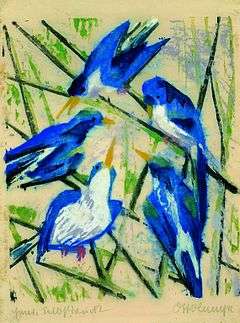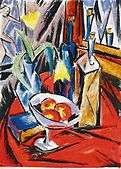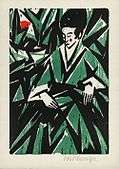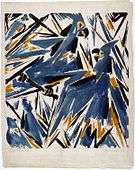Otto Lange
Otto Lange (1879 – 19 December 1944) was a German Expressionist painter and graphic artist.

After an apprenticeship as a decorator, he became a pupil of the Kunstgewerbeschule in Dresden and then studied at the Otto Gussmann Academy of art. From 1919 he lived in Dresden, where, alongside Otto Dix, Conrad Felixmueller, Otto Schubert and Lasar Segall, he co-founded the Dresdner Sezession group, a short-lived collaboration of German Expressionism. The works of this new generation of disillusioned artists placed a much greater emphasis on political and social reformation through pacifistic means, rather than adopting the nihilistic social criticism and cynicism of their Die Brücke predecessors. From 1921 he was a member of the Academic Council of Saxony and in 1925 he was appointed Professor of the State Art School for Textile Industry, Plauen by Karl Hanusch. In 1926 he painted the Lutheran church in Ellefeld, Vogtland.
Lange was arrested by the National Socialists in 1933, and lost his professorship. He then worked as a freelance artist in Dresden. In 1938, two of his paintings were shown at the Berlin Degenerate Art Exhibition.
Lange produced an extensive body of printed graphic work; his subjects ranged from religious representations to still-lifes to book illustrations. In contrast to other expressionist woodcutters, Lange mainly used the elaborate technique of high pressure colour printing. Most of the time Lange did not print his work with a press, but instead made hand rubs after he had dyed the printing stick instead of the roller with the brush.
Gallery
-

Still life with red ceiling, 1916. Colour woodcut
-

Lady in green, 1918. Colour woodcut
-

Parrots, 1917
-

Girl with doll, 1917
References
- Richard Stiller: Otto Lange. In: Illustrirte Zeitung (Leipzig) 153 (1919), Nr. 3988, S. 706f.
- Staatliche Kunstsammlungen Dresden (Hrsg.): Kunst im Aufbruch – Dresden 1918–1933. Dresden 1980.
- Städtisches Kunstmuseum Spendhaus Reutlingen (Hrsg.): Mit Leidenschaft ins Holz gerissen. Der Dresdner Expressionist Otto Lange (1879–1944). Reutlingen 2011, ISBN 978-3-939775-26-3.
- Claudia Schönjahn: Monumentale Graphik! Otto Lange (1879–1944); Leben und Werk; Werkverzeichnis seiner Druckgraphik Petersberg 2014, ISBN 978-3-86568-982-5
External links
- Literature by and about Otto Lange in the German National Library catalogue
- Aquarelle portrait of a girl, 1920
- Head of Christ, 1916